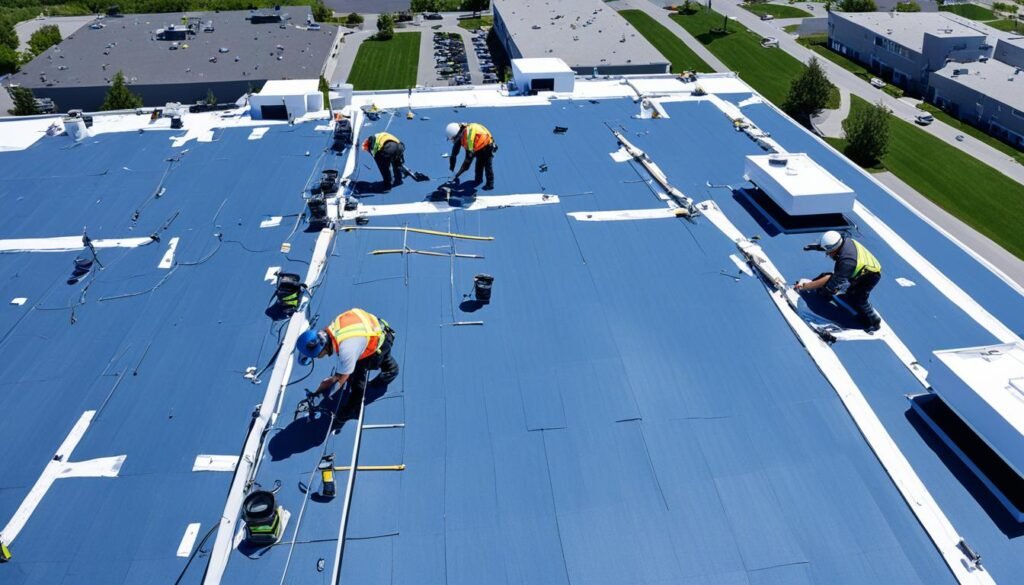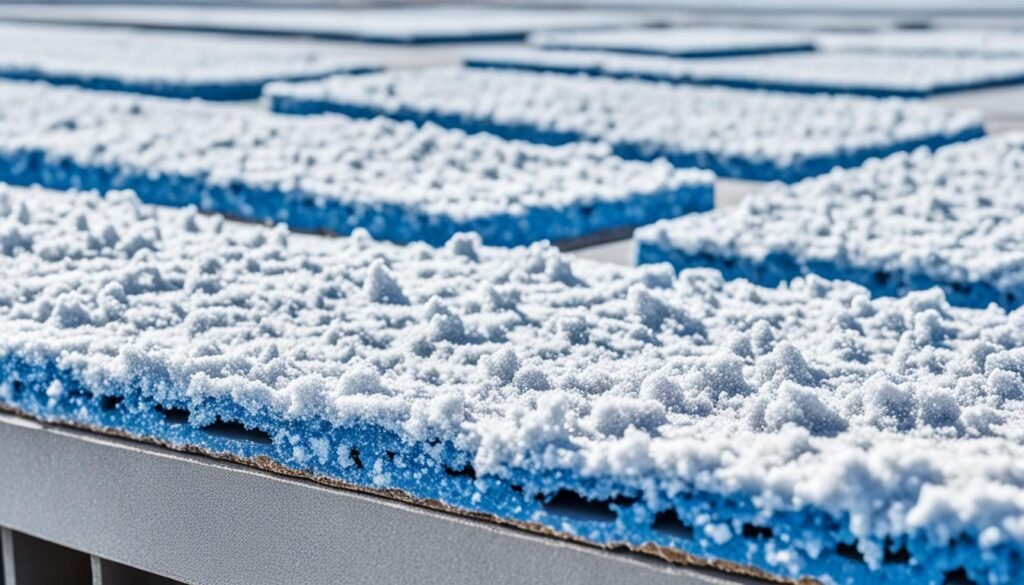Did you know that commercial roof damage can cost businesses billions of dollars each year in repair and replacement expenses? The importance of maintaining a proactive approach to prevent roof damage cannot be overstated.
- Implementing effective prevention strategies can save businesses significant costs in commercial roof repair and replacement.
- Choosing the right roofing materials based on factors like climate, structure, and budget is crucial for preventing roof damage.
- Regular maintenance and inspections help identify and address potential issues before they escalate.
- Weatherproofing, insulation, and storm preparedness are essential for protecting commercial roofs from extreme weather conditions.
- Professional roof inspections, budgeting, and warranty coverage are key aspects of preventive maintenance.
Choosing the Right Roofing Materials
Selecting the appropriate roofing material is crucial in preventing commercial roof damage. The right choice not only enhances the durability and lifespan of your roof but also provides optimal protection against external elements. Consider the following roofing materials when making your selection:
TPO Roofing
TPO (Thermoplastic Olefin) roofing is a popular choice for commercial buildings due to its excellent durability and energy efficiency. It offers superior resistance to UV rays, chemical exposure, and punctures. TPO roofing is also known for its flexibility and ease of installation.
PVC Roofing
PVC (Polyvinyl Chloride) roofing is another durable and reliable option. It provides outstanding resistance against weather elements, chemicals, and fire. PVC roofing is highly flexible, making it suitable for buildings with complex roof structures.
Metal Roofing
Metal roofing, such as steel or aluminum, offers exceptional longevity and durability. It can withstand harsh weather conditions, including heavy rain, snow, and high winds. Metal roofs are also energy-efficient and environmentally friendly.
Modified Bitumen Roofing
Modified bitumen roofing is a popular choice for flat or low-slope commercial roofs. It is known for its excellent waterproofing capabilities and resistance to extreme weather conditions. The multiple layers of bitumen provide superior protection against water infiltration.
Green Roofing
Green roofing, also known as living roofs, is an environmentally friendly option that provides numerous benefits. It consists of vegetation, creating a natural barrier against UV radiation, reducing the heat island effect, and improving air quality. Green roofing also offers insulation, reducing energy consumption.
When choosing the right roofing material for your commercial building, consider factors such as climate, structure, budget, and desired aesthetics. Consulting with a professional roofing contractor will ensure that you make an informed decision that meets your specific needs.
Regular Maintenance and Inspections
Regular maintenance and inspections are essential to prevent commercial roof damage. By implementing routine maintenance practices and conducting regular inspections, you can identify potential issues and address them promptly, saving your business from costly repairs and disruptions.
Inspect the Roof Regularly
Regular roof inspections allow you to detect signs of damage or wear early on. Walk the entire roof surface and look for cracks, blisters, or areas of pooling water. Note any loose or missing shingles, damaged flashing, or deteriorated sealants. Pay attention to the roof’s drainage system, including gutters, drains, and downspouts, ensuring they are clear of debris and functioning properly.
Clear Debris and Clean Gutters and Drains
Clearing debris, leaves, and branches from your roof helps prevent clogs and water accumulation. Regularly clean gutters, downspouts, and drains to ensure water can flow freely off the roof. Be cautious when performing these tasks and use appropriate safety equipment.
Trim Overhanging Trees
Overhanging tree branches can cause several problems for commercial roofs, including physical damage from falling branches, increased debris accumulation, and excess shade that promotes moisture retention. Trim branches that are too close or touching the roof to minimize these risks.
Address Issues Promptly
If you notice any signs of damage or wear during inspections, address them promptly. Timely repairs prevent damage from worsening and reduce the risk of leaks or structural issues. Consult with a professional roofing contractor to assess the extent of the damage and determine the most appropriate repair solutions.
Seal Roof Penetrations
Roof penetrations, such as vents, skylights, or HVAC units, can be potential entry points for water and cause leaks. Ensure these penetrations are properly sealed and watertight to prevent moisture infiltration and damage to the underlying roofing system.
Consider Roof Coatings for Added Protection
Roof coatings can provide an additional layer of protection for your commercial roof. They can help extend the lifespan of your roof by reducing UV damage, preventing water penetration, and improving energy efficiency. Consult with a professional roofing contractor to determine if a roof coating is suitable for your roof type and current condition.
By implementing these roof maintenance best practices and conducting regular inspections, you can proactively prevent commercial roof damage and ensure the longevity of your roofing system.

Proper Weatherproofing and Insulation
Weatherproofing and insulation play a crucial role in safeguarding your commercial roof from damage caused by severe weather conditions. By implementing effective weatherproofing measures and ensuring proper insulation, you can significantly enhance the durability and resilience of your roof. Here are some key steps you can take to protect your commercial roof:
1. Insulation for Temperature Regulation
Proper insulation is essential for maintaining optimal temperature levels within your commercial building and preventing energy loss. It creates a barrier that minimizes heat transfer, helping you to regulate indoor temperatures and reduce the strain on your HVAC system. Insulation also plays a crucial role in preventing the formation of ice dams, which can lead to water infiltration and roof damage.

2. Attic Ventilation
Maintaining adequate attic ventilation is vital for promoting air circulation and preventing moisture buildup. Proper ventilation helps to regulate temperature levels, preventing condensation and the risk of mold growth. Additionally, it helps in reducing heat buildup during hot seasons, which can cause premature aging and deterioration of roofing materials.
3. Reinforcing Roofing Components for Storm Preparedness
When it comes to storm preparedness, reinforcing your roofing components is paramount. Consider installing impact-resistant materials and reinforcement systems to strengthen your roof’s ability to withstand high winds, hail, and flying debris. This proactive approach can minimize the risk of storm-related damage and potential water infiltration.
4. Snow Removal Plan
In regions prone to heavy snowfall, having a snow removal plan is crucial to prevent the accumulation of excessive weight on your commercial roof. Excessive snow on the roof can lead to structural strain, increased risk of collapse, and potential water damage when the snow begins to melt. Engage professional snow removal services to safely and efficiently clear snow from your roof.
5. Waterproofing Vulnerable Areas
Vulnerable areas on your commercial roof, such as joints, penetrations, and flashing, are prone to water infiltration during heavy rainfall. Applying appropriate waterproofing solutions to these areas can provide an additional layer of protection and prevent water damage. Consult with a professional roofing contractor to identify vulnerable areas and apply suitable waterproofing materials.
By prioritizing weatherproofing and insulation, you can mitigate the risk of commercial roof damage caused by extreme weather conditions, ensuring the longevity and durability of your roofing system.
Professional Roof Inspections and Budgeting
Regular professional roof inspections are crucial for the long-term health of your commercial roof. By scheduling inspections with qualified roofing contractors, you can identify potential issues early on and address them before they turn into costly repairs. During these inspections, the contractors will thoroughly assess the condition of your roof, document any findings, and provide recommendations for repairs and maintenance.
When obtaining roofing quotes, it’s important to consider more than just the immediate costs. Think about the long-term expenses associated with the materials, labor, and maintenance required for your commercial roof. Allocating a budget for emergency repairs is also essential in case unexpected issues arise. By proactively setting aside funds for emergencies, you can have peace of mind knowing that your roof can be promptly repaired, minimizing any damage to your building.
Additionally, warranty coverage is an important aspect to consider when budgeting for your commercial roof. Evaluate the details of the warranty, including the length of coverage, what it includes, and any exclusions. Understanding your warranty can help you determine the level of protection it offers and if additional coverage may be needed.
By prioritizing professional roof inspections, budgeting for long-term costs, emergency repairs, and evaluating warranty coverage, you can proactively prevent commercial roof damage. Investing in the proper care and maintenance of your roof will ensure its longevity and save you from potential costly repairs down the line.
FAQ
What are some strategies for preventing commercial roof damage?
To prevent commercial roof damage, it is important to choose the right roofing materials, conduct regular maintenance and inspections, ensure proper weatherproofing and insulation, and schedule professional roof inspections.
What are some common types of roofing materials for commercial buildings?
Common types of roofing materials for commercial buildings include single-ply membranes like TPO and PVC, built-up roofing (BUR), metal roofing, modified bitumen roofing, and green roofing.
What maintenance practices can I follow to prevent commercial roof damage?
Regular maintenance practices include inspecting the roof for signs of damage or wear, clearing debris, cleaning gutters and drains, trimming overhanging trees, repairing issues promptly, sealing roof penetrations, and considering roof coatings for added protection.
How can I protect my commercial roof from extreme weather conditions?
To protect your commercial roof from extreme weather conditions, ensure proper insulation to regulate temperatures and prevent ice dams, maintain proper attic ventilation, reinforce roofing components for storm preparedness, have a snow removal plan, and consider waterproofing vulnerable areas.
Why are professional roof inspections important for commercial buildings?
Professional roof inspections are vital in identifying potential issues early on. Schedule inspections with qualified roofing contractors, document inspection findings, and follow their recommendations for repairs and maintenance. Additionally, having a budget for emergency repairs and evaluating warranty coverage can help prevent commercial roof damage and ensure the longevity of your roof.
